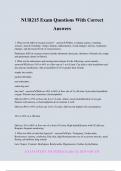NUR215 Exam Questions With Correct
Answers
1. What are the S&S of oxygen toxicity? - answer✔✔Pallor, sweating, nausea, vomiting,
seizures, muscle twitching, vertigo, tinnitus, hallucination, visual changes, anxiety, respiratory
changes, and decreased levels of consciousness.
Pulmonary S&S of oxygen toxicity include substernal chest pain, shortness of breath, dry cough,
and pulmonary edema or fibrosis.
2. What are the indications and nursing interventions for the following: nasal cannula, -
answer✔✔Delivers 24% to 44% at a flow rate of 1 to 6 L/min. Can lead to skin breakdown and
dry mucous membranes. Add a humidifier if O2 is greater than 4L/min.
simple face masks,
partial rebreather,
non-rebreather,
ambu-bag and
face tent? - answer✔✔Delivers 40% to 60% at flow rate of 5 to 8L/min. It provides humidified
oxygen. Patients may experience claustrophobia.
Delivers 60% to 75% at flow rate 6 to 11 L/min. Allows easier humidification of oxygen.
Patients with anxiety or claustrophobia do not tolerate it well.
Delivers 80% to 95% at flow rate 10 to 15 L/min. Delivers the highest O2 concentration.
24% to 50% at 4-10L/min
Delivers 24 to 100% at flow rate of at least 10 L/min. High humidification with O2 delivery.
Requires frequent monitoring.
3. What are S&S of early/late hypoxia? - answer✔✔Early: Tachypnea, Tachycardia,
Restlessness, anxiety, confusion, Pale skin, high blood pressure use of accessory muscles, nasal
flaring, adventitious lung sounds.
Late: Stupor, Cyanotic, Bradypnea, Bradycardia, Hypotension, Cardiac dysrhythmias.
EXAM STUDY MATERIALS July 26, 2024 9:30 AM
, Chronic: Clubbing of the finger and toes, peripheral edema, right sided heart failure, respiratory
acidosis, oxygen saturation less than 87%
4. How often should oral care be done on patients on oxygen therapy minimum? -
answer✔✔Give oral care BID minimum
5. What are some nursing diagnoses for pneumonia? Nursing interventions? -
answer✔✔Diagnosis: Ineffective Airway clearance r/t inflammation and presence of secretions.
Interventions: Position the client to fowlers position to optimize respiration.
6. How would you educate a patient on safe home oxygen therapy? - answer✔✔No smoking
while oxygen in use, do not use volatile, flammable material such as alcohol or acetone near
oxygen or while receiving oxygen. Tank must sit up.
7. What should you do first if you notice a patient's oxygen level is low? How do you -
answer✔✔Place the patient in semi-fowlers or Fowler's position to promote chest expansion and
maximize ventilation. Encourage deep breathing.
8. What are the different adventitious breath sounds? - answer✔✔Wheezing, crackles, rhonchi,
stridor, Pleural friction rub.
9. What are the different breathing patterns? - answer✔✔Eupnea—Normal breathing
Tachypnea—Fast, shallow breathing; more than 24 breaths/minute. draw limited air into the
alveoli and may result in hypoventilation.
Bradypnea—Slow respirations (fewer than 10 breaths/minute). cause poor gas exchange.
Kussmaul's respirations—Regular but increased in rate and abnormally deep respirations. form
of hyperventilation caused by fear, anxiety, or panic.
Biot's respirations—Irregular respirations of variable depth (usually shallow), alternating with
periods of apnea.
Cheyne-Stokes respirations—Gradual increase in depth of respirations, followed by a gradual
decrease in depth, then a period of apnea.
Apnea—Absence of breathing.
10. What teaching should we do with a patient with asthma? - answer✔✔A peak expiratory flow
meter should be used daily to help the patient track his or her lung function. Using a peak
expiratory flow meter when symptoms occur can help the patient decide how to treat his or her
symptoms. The patient should be taught to avoid known triggers such as smoke, pollen, and cold
air. Additionally, they should be told to always keep their rescue inhaler with them. If the patient
often experiences symptoms with activity, the patient might benefit from pretreating with a
bronchodilator. Many over the counter drugs can interact with asthma medication or have been
known to induce symptoms. The patient should be taught to avoid these unless they are approved
by their doctor.
EXAM STUDY MATERIALS July 26, 2024 9:30 AM




